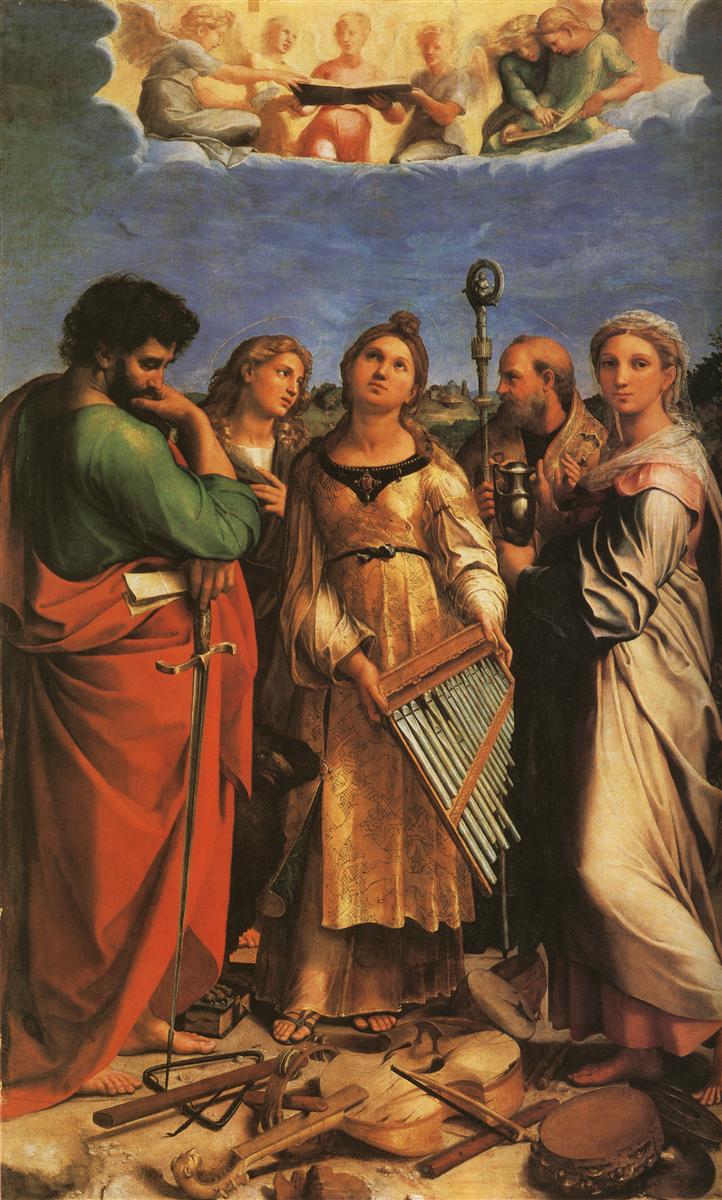Saint Cecilia with Saints Paul, John the Evangelist, Augustine and Mary Magdalen (Ecstasy of Saint Cecilia)
Story
The very famous painting, masterpiece of Raphael’s later years, depicts the moment of the ecstasy of St. Cecilia, when the saint lets the reeds of the portative organ slip through her hands, symbol of earthly joys, and turns her gaze towards the choir of angels, emblem of divine love.
The saints that surround her are not involved in Cecilia’s mystical experience, but with the play of glances, which also express the idea of absolute love as opposed to earthly love. St. Paul meditates observing the musical instruments on the ground, the Saints John and Augustine are concentrated in an intense exchange of looks. Mary Magdalen turns toward the observer inviting him to witness the mystery and showing the vase containing the oil with which she, moved by love, wishes to anoint the feet of Christ. Raphael gave the human figure the central role in the representation by bringing the group of saints together in a confined semi-circular space that alludes to the apse of a church and reduces the landscape in the background.
The originality of the “still life” of the musical instruments in the foreground is extraordinary. For this Raphael enlisted the help of his pupil and assistant Giovanni da Udine.
The painting was executed in Rome and then brought to Bologna to be placed in the church of San Giovanni in Monte in the chapel of Elena Duglioli dall'Olio’s family.
Elena, a cultivated woman, devout and dedicated to charitable works, starting in 1506 was deeply venerated in the city: her life was likened to that of Saint Cecilia for practicing chastity within marriage and her mystical visions.
The subject therefore revolves around the identification between Cecilia and Elena expressed in the iconography of ecstasy and its collateral themes: the renunciation of life’s worldly pleasures is represented by musical instruments broken and thrown to the ground, while the exaltation of virginity and the traditional symbol of chastity is the high belt that closes the Saint’s very sophisticated robe.
Giorgio Vasari, who is the oldest source, attributed the commission to Cardinal Lorenzo Pucci, brother of Bishop Antonio Pucci, during his stay in Bologna, when he formed a relationship with Elena Duglioli dall'Olio.
The arrival of the painting by the greatest artist of the papal court with a subject connected to the worship of Elena Duglioli, for Bologna represented an important propaganda element for restoring papal power.
In the Emilian artistic environment, stylistic excellence and the innovative scope of the “Santa Cecilia” met with varying degrees of understanding and interpretation. However, the evocative power of the work was so great that it constituted the pivot around which the evolution of local painting revolved up until the seventeenth century
